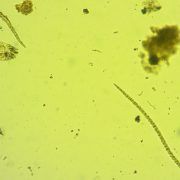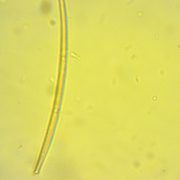Nematodes are microscopic threadlike organisms which form part of the soil food web; in fact the word nematode comes from the Greek word meaning thread. Nematodes in the soil are grouped into two classes: free living nematodes (the good) and parasitic nematodes (the bad). The parasitic nematodes are those that attack plant roots and cause diseases, while free living nematodes refer to those that are beneficial in the soil. Because of the harmful impact parasitic nematodes have, a lot more research has been done on them than on the free living ones. This blog however will focus more on good nematodes.
The good nematodes
These nematodes can be studied and their presence in the soil can tell you about the abundance of other microbes such as bacteria, fungi and other nematodes. This is due to the fact that most of the nematodes in this group have a very strict diet. Bacterial feeders/grazers, otherwise known as bacterivores, only feed on bacteria; fungi grazers (fungivores) only feed on fungi, while predatory nematodes feed on protozoa and other nematodes. For example, soil that has a high bacteria population is most likely to have an abundance of bacterivorous nematodes. It is important that a soil food web contains all of these types of nematodes, especially the predators, in order to maintain the balance. Predatory nematodes act as biological control agents by controlling the bacterial and fungi populations in the soil, ensuring that over-feeding of bacteria and or fungi by other nematodes or protozoa is avoided. Another important role of free living nematodes is their ability to revive old and inactive bacterial or fungal colonies. Nematodes do this by carrying them to fresh organic material which provides easily digestible food thereby giving these microbes a better chance of being activated.
Nematode counts give information about the abundance of other microbes such as bacteria and fungi
Nematodes can be categorized into groups based on the shape of their mouth
Nematodes don’t move much in soil as they have been reported to only move no more than 1 meter in their entire life cycle. The major way in which they spread in a field is through tillage which could possibly lead to nematode infestation, especially if the nematodes being spread are the bad ones. There are 2 ways in which they can spread through tillage: 1) transference of their eggs by wind to other parts of the field, and even to neighbouring farms, induced during tillage; 2) transference by the tillage implement to other parts of the field.
The bad nematodes
These types of nematodes are a nightmare to deal with because they can cause very serious plant diseases. These nematodes puncture the plant roots and suck out fluids from the plant causing the plant to wilt. When a nematode attacks the plant it opens up the plant to all sorts of vulnerabilities. The plant’s defence system is weakened, causing it to be susceptible to attacks from other bad microbes and pests. Farmers should be careful not to implement management practices that could cause the possible spread of bad nematodes in their fields, especially because the infestation of the bad nematodes is very difficult and expensive to control.
The role played by nematodes is important in the soil. Not only are they critical in maintaining balance of the food web but also their presence in the soil provides an ability to estimate the amount of other microbes. It is however important that further research is carried out in order to better understand the role of good nematodes in the soil ecosystem.
- The management of soils with excessive sodium and magnesium levels - 2023-06-12
- Understanding evapotranspiration better - 2021-10-18
- Soil fungi connections - 2021-09-28


